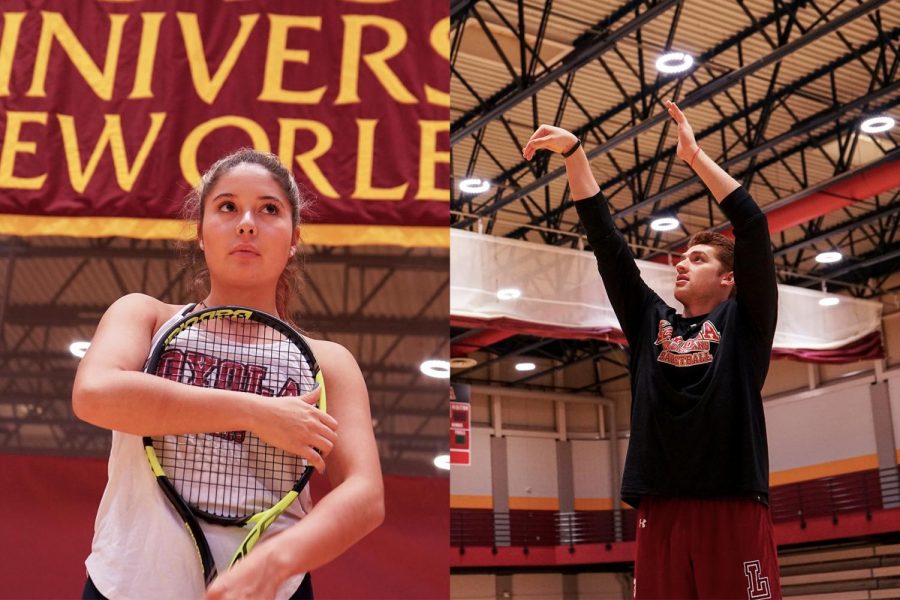Athletes transfer to find their “home”
Madelynn Chavez, political science sophomore, who transferred from University of New Mexico, stands in the gym on Jan. 10. Chavez is one of a few student athletes who transferred to Loyola from an NCAA school. Andrew Fava shoots hoops in the gym on Jan. 10. Fava transferred to Loyola from University of Florida.
January 27, 2020
Upon graduating high school, it becomes a concern of students, especially student- athletes as to which college they will carry their talents. Athletes consider pros and cons in a school before they make their ultimate decision, and even after doing so, their decision may not be ideal.
Madelynn Chavez, political science sophomore, decided that she would attend the University of New Mexico upon graduating from high school, where she walked onto the tennis team. Chavez liked the coach, but when he had to step away for personal reasons, she did not like the feel of the team anymore.
“I no longer felt like a part of the team and [the new coach] didn’t allow me to travel at all in the spring. I decided to be a walk on at UNM to get stronger and potentially play in the lineup, but I soon began to realize that with my new coach it would never be a possibility,” said Chavez.
After this realization, Chavez decided to transfer. When she arrived at Loyola, she noticed some significant differences between the National Collegiate Athletic Association and her new, smaller conference.
“At Loyola, I feel a lot more relaxed. I love how small the campus is because I no longer have to stress about being late to class or not having time to shower in between practice and class. I also love how small my classes are because I feel like my professors genuinely know me and would want to help me if I ever needed it,” said Chavez.
Though Loyola is not in the NCAA, Chavez has only found a few key differences about playing at a school in the National Association of Intercollegiate Athletics.
“The key difference between the two is that at Loyola if I was stressed about a paper or exam coming up, I could take a day off of practice without feeling like I would get punished. Another difference is that at Loyola I am allowed the weekends off to recover and at UNM we would often have to practice on Saturdays as well,” said Chavez.
In her first tournament as a member of the Wolf Pack, Chavez brought home a victory to start the early season off with a good start. When the team traveled to compete against Mississippi Gulf Coast Community College, Chavez played doubles with Andrea Martinez, biological science sophomore, and the duo did not drop a set.
Andrew Fava, a graduate student that transferred from the University of Florida to play basketball, has seen similar aspects of competing in the NAIA after playing in the NCAA.
“The competition level is just as high, but the main difference is the size of the players. Generally, most players in the NAIA are 6’8” and under, from what I have experienced. In the NCAA, every team has at least one, if not multiple, 6’11” to 7 footers” said Fava.
Fava played in two seasons at Florida. He mentioned a significant feat of his as hitting a 3-pointer in a win vs. the University of North Florida. That 3-pointer helped Florida tie an NCAA record of having nine players score a 3-pointer in a game. Since joining the Loyola men’s basketball team, Fava has played in six games and started in three. In those six games, he was responsible for 101 points and averaged 16.8 per game.
Fava has learned to be an all-around player, on and off the court. He said being at the bottom of the roster at Florida taught him the skills he needed to be a leader on campus and on the sidelines. When he came to Loyola, he knew that role would change.
“At Loyola, I became a leader on the court and stepped in as a guy with a lot more experience than anyone else on the team,” said Fava.
This experience that Fava brings to Loyola has helped him find another role on the team after suffering from a season ending injury.
“I have taken a role as a player-coach, if you will. I do my best to help communicate things to my teammates and help them in practice and games. Recently, I have been helping some of the players with their shooting mechanics in the hopes of helping the team win more games. It has been a lot of fun in all of my roles,” said Fava.







